A Japandi-style dining room blends Japanese and Scandinavian influences—warm wood tones, minimalist decor, and a calming simplicity. This fusion design philosophy embraces simplicity, natural materials, and a calming atmosphere.making it perfect for creating a serene dining space. Below, discover ten Japandi-inspired decor tricks to transform your dining room. Each trend is easy to apply, with real-world tips, a touch of personal insight, and a stylish product suggestion to bring the idea home.
1. Embrace Neutral, Earthy Tones
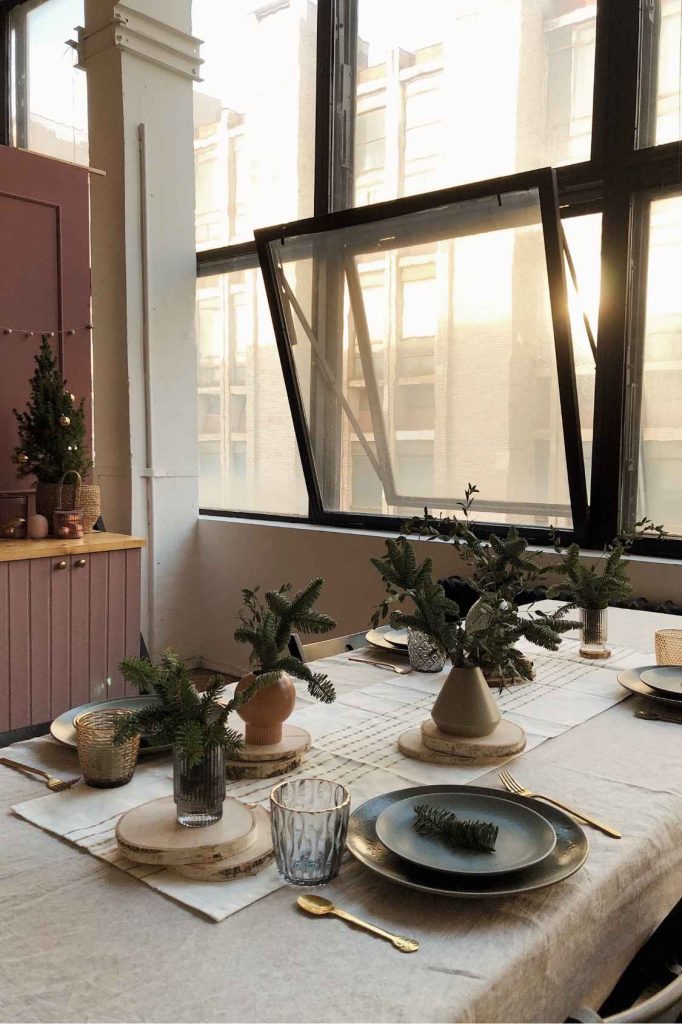
Start with a neutral and earthy color palette as your canvas. Japandi interiors favor soft whites, beiges, warm grays, and gentle earth tones that instantly set a tranquil mood . Don’t worry—neutral doesn’t mean boring. In my experience, a backdrop of creamy whites or muted taupe actually makes the space feel larger and more relaxing, allowing your furniture and textures to shine. Personal tip: I was initially hesitant about ditching bold colors, but once I painted my dining area a pale sage gray, it felt like a breath of fresh air every time I sat down for a meal. To incorporate this trend, consider textiles and tableware in earthy hues: for example, swap in a set of matte stoneware dinner plates in soft sand or gray, and use natural linen table napkins to echo the room’s neutral vibe. These simple color changes create a cohesive, calming backdrop that lets your food (and company) take center stage.
2. Use Natural Materials (Wood & Stone)
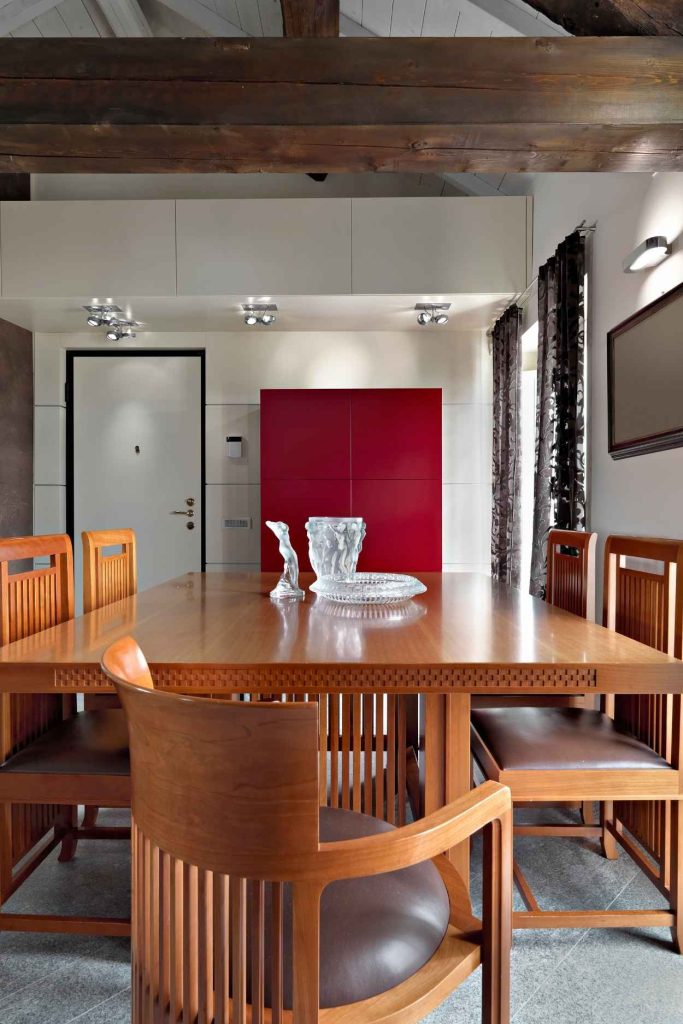
Bring nature to the table—literally—by featuring natural materials like wood, stone, and bamboo in your dining room. Japandi style is all about infusing organic elements that add warmth and authenticity. A solid wood dining table or sideboard instantly grounds the room and introduces that warm, inviting character only wood can provide. In my own home, the oak dining chairs and reclaimed wood table are always conversation starters; their organic grains and knots double as art and remind me of the outdoors. Stone accents are another Japandi favorite for a touch of wabi-sabi elegance. You might place a smooth river stone centerpiece or incorporate stoneware ceramics on your table for natural texture. Product-wise, look for wooden furniture with clean lines—think a walnut or oak dining table, or simple chairs with wooden frames. You can also add a stone element, like a set of ceramic dinner plates or a marble serving platter, to bring that earthy, grounded feel to your table setting. These natural materials not only look stunning but also create a dining atmosphere that feels connected to the earth and truly timeless.
3. Prioritize Functional Minimalism

When it comes to Japandi dining rooms, less is more—but it has to work hard. This style thrives on functional minimalism, meaning every piece in your dining area should have a purpose or bring joy (ideally both). The goal is an uncluttered, serene atmosphere, so edit out any unnecessary items crowding your space. I find that keeping just a few beloved items on display (like a beautiful bowl on the table and a lamp on the credenza) makes the room feel open and stress-free. Plus, it’s way easier to clean up after dinner when you’re not navigating around piles of decor! To nail this trend, choose furniture with built-in function or storage. For example, a sleek sideboard or cabinet can hide away your extra plates and table linens, maintaining a tidy look. Likewise, a simple bar cart or a floating shelf can showcase a couple of pretty ceramic pieces without overwhelming the room. By ensuring everything in your dining area is purposeful and streamlined, you create a harmonious space where style and function meet. (Your future self who doesn’t have to declutter constantly will thank you.)
4. Choose Low-Profile Furniture
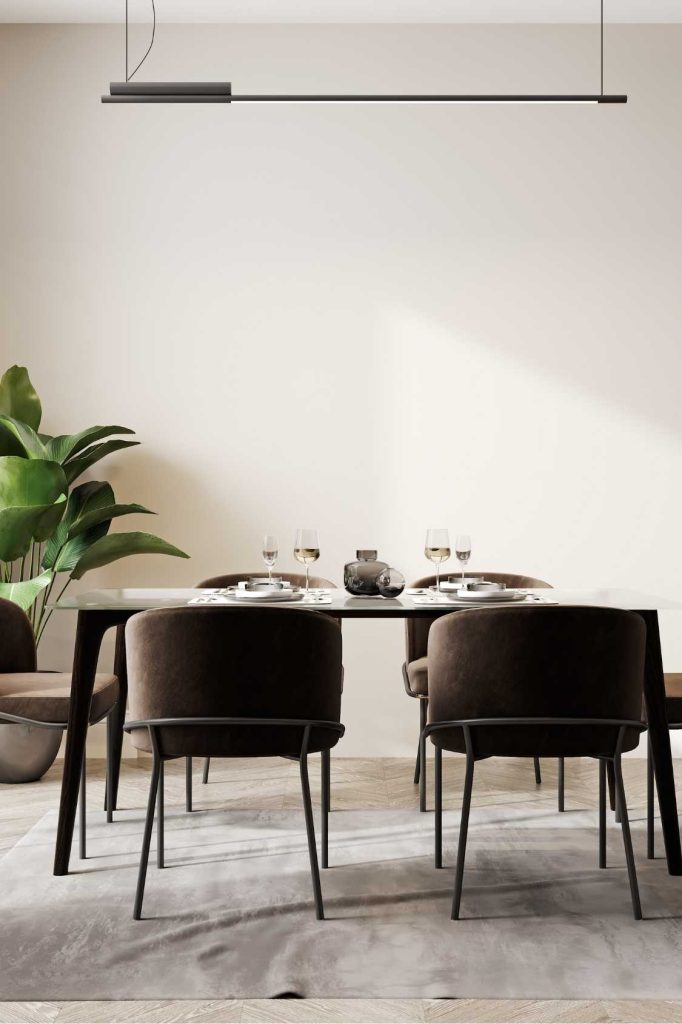
In Japandi design, the furniture doesn’t shout for attention—it whispers elegance. One key trick is opting for low-profile furniture in your dining room. Low-profile means pieces with a lower height or a sleek silhouette that keep sightlines open and make the room feel airy. Imagine dining chairs with low backs or a bench seat that tucks neatly under the table; these choices prevent visual clutter and lend a relaxed, casual vibe. When I swapped my bulky high-back chairs for low-back wooden chairs, my dining room instantly felt twice as spacious. The room now invites you to linger, as if it’s gently hugging the ground in true Japanese style. For a traditional touch, you could even try a low Japanese-style dining table with floor cushions (tatami style) for an intimate, cozy meal—though wooden chairs or low benches are more practical for everyday use and still capture that look.Product suggestion: seek out dining chairs with clean lines and a low profile, perhaps with subtle curved backs that support without dominating the view. A backless wooden bench is another chic option alongside a table, fostering a communal, bench-style dining experience that’s both Scandinavian-casual and Zen. Low-profile pieces keep your dining area feeling open, balanced, and utterly Zen.
5. Layer Different Textures
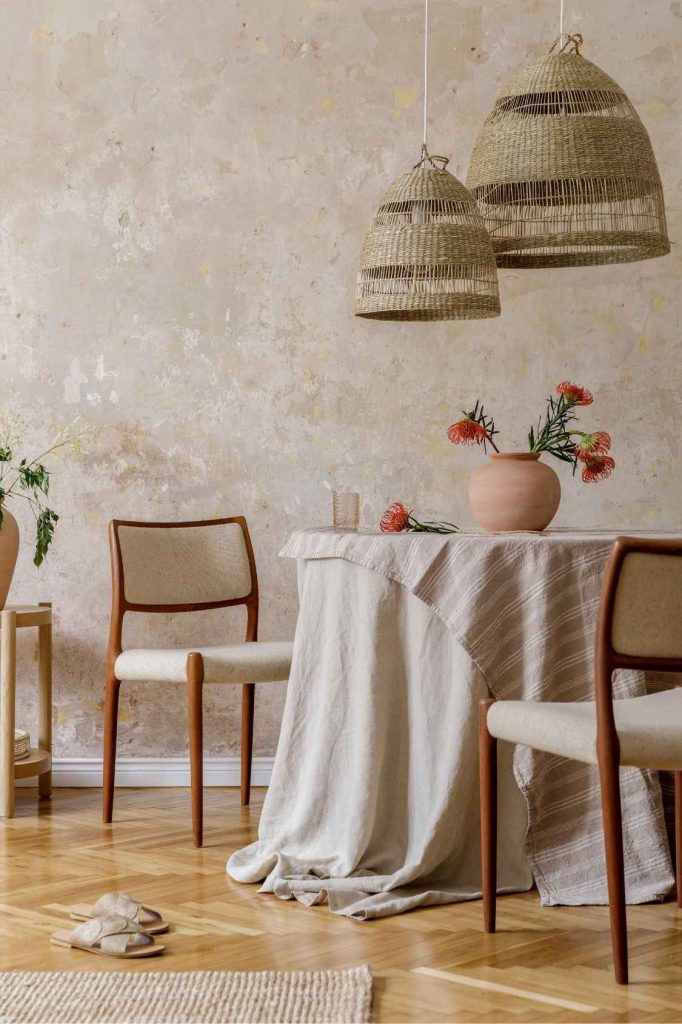
If you’re keeping things minimal in color and decor, texture becomes your secret weapon to add interest. Japandi style shines when you mix textures like linen, ceramic, wood, and leather for a rich, layered effect that’s still subtle. The interplay of different materials creates depth in an all-neutral palette, making the room feel cozy yet refined. I love draping a soft linen runner across my smooth wooden dining table – the contrast between fabric and wood is simple but so satisfying. You can do this with many elements: maybe pair woven placemats with sleek ceramic plates, or add leather cushions to your rattan-seat chairs. The idea is to engage the senses; for example, muted ceramic dinnerware and natural wood serving bowls bring a warm, tactile quality to the table .In one corner of my dining room, I even hung a woven wall tapestry to break up the flat wall (it doubles as subtle art and texture). To try this trend, look at your dining space and identify opportunities to introduce a new material. Perhaps add linen or cotton slipcovers to chairs, place a chunky knitted throw over a bench, or set a rough-hewn pottery vase on a smooth console. By layering textures—nubby, smooth, hard, soft—you’ll make your Japandi dining room feel inviting and full of quiet character, without adding any clutter at all.
6. Opt for Sculptural Simplicity
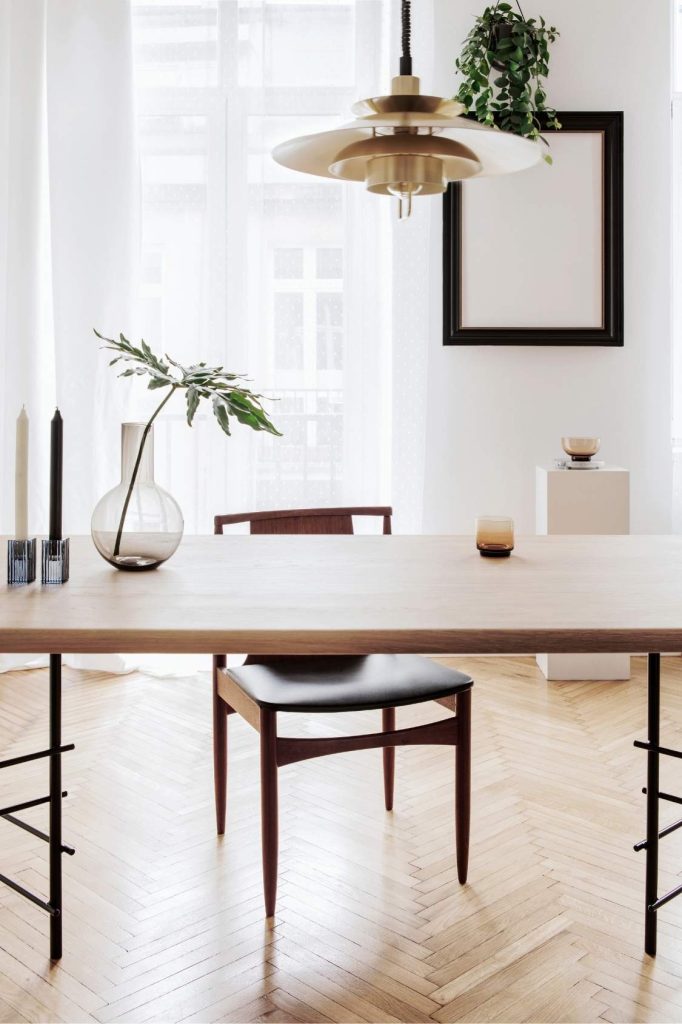
Japandi decor proves that sometimes one striking piece is all you need. Embrace sculptural simplicity by choosing a few decor elements that double as art with their simple, beautiful forms. Rather than filling your dining room with lots of knick-knacks, pick a statement piece or two that really stand out in a subtle way. For instance, a pendant light can be more than just illumination – a pendant with a sculptural shape (like a graceful paper lantern or a bamboo woven drum lamp) becomes a focal point over the dining table. I treated my own lighting as sculpture: a dome-shaped rattan pendant lamp in my dining area draws eyes upward and casts a lovely patterned glow at night. You could also consider an elegant ceramic vase or bowl as a centerpiece; something handcrafted with an organic shape adds that artful touch. One of my favorite tricks is placing a single sculptural object on the sideboard, like a smooth stoneware sculpture or an abstract wooden carving. It’s minimal decor that speaks volumes. For product ideas, look for handmade ceramics or artisan glassware that have unique shapes—perhaps a speckled pottery bowl or a set of curvy candlesticks. Even wall art can be approached sculpturally: a simple 3D art piece or a framed minimal line drawing can act as the room’s understated artwork. The key is to let these sculptural pieces breathe; give them space and they’ll elevate the whole room’s aesthetic with their simplicity.
7. Add Zen-Inspired Accents
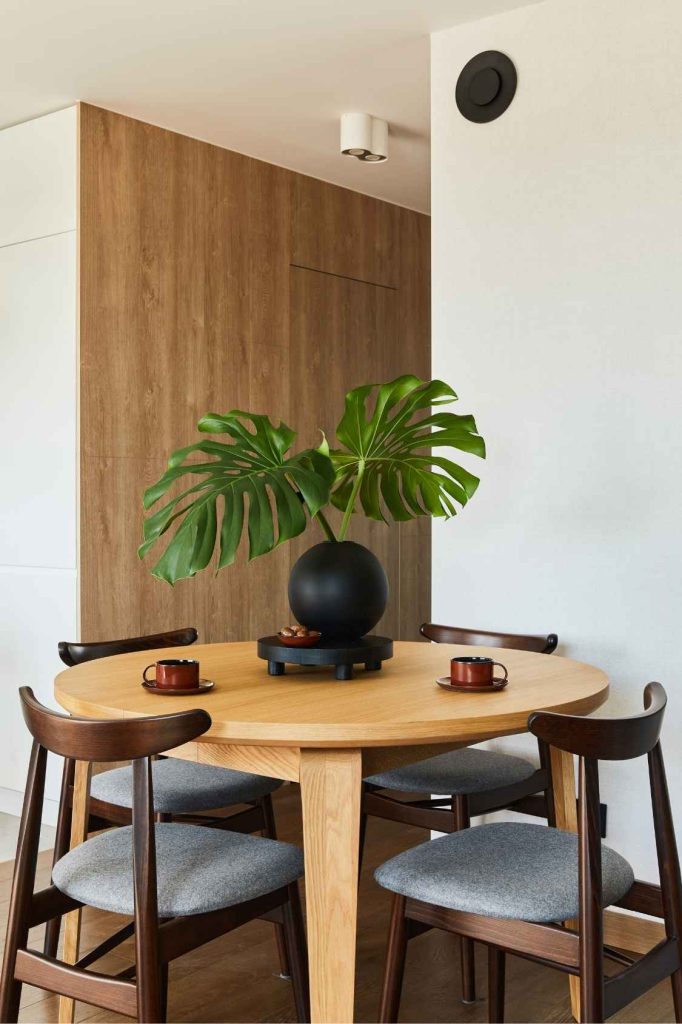
To truly capture the Japanese side of Japandi, sprinkle in a few Zen-inspired accessories that bring a sense of tranquility and mindfulness to your dining room. These accents are all about evoking calm and nature. For example, consider incorporating a small bonsai tree or a dish garden with succulents as a living centerpiece – it’s a beautiful nod to nature and makes a great conversation piece. I keep a tiny bonsai on my credenza, and tending to it has become a relaxing ritual (plus it looks like a miniature work of art). Another idea is to create an Ikebana-style flower arrangement: place a single branch or a few blooms in a simple vase. This kind of minimal Japanese floral display is not just decor but a meditation on form and balance. On the walls, opt for calming art such as a monochromatic landscape print or a piece of Japanese calligraphy; one well-chosen calming wall art piece can set a serene tone for the whole room. Smaller accessories can have a Zen touch too – think of a ceramic tea set displayed on an open shelf or a smooth stone incense holder on the side table for a subtle fragrance during or after meals. My personal favorite zen accent? A tiny tabletop zen garden with sand and stones that I rake into patterns now and then; it’s oddly satisfying and adds texture to a side shelf. These touches, while subtle, infuse your space with personality and a sense of peace. Just a few thoughtful, Zen-inspired accents (and maybe the gentle presence of a bonsai) will make your dining room feel like a calm retreat where you can truly savor your meals.
8. Soften with Ambient Lighting
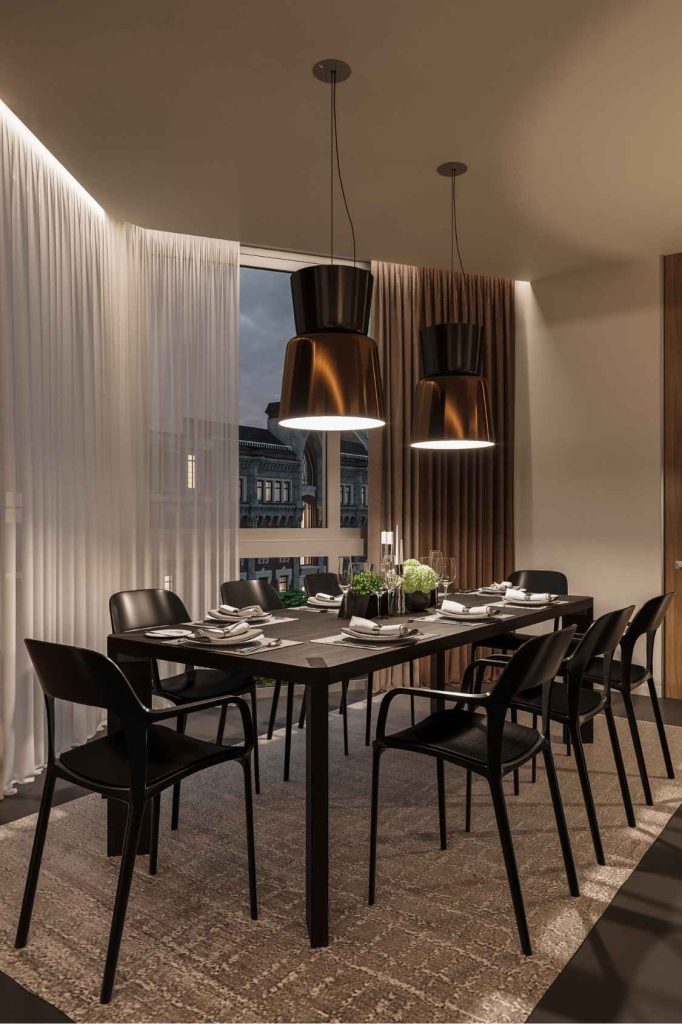
Lighting can make or break the mood, and in a Japandi dining room the motto is soft, ambient lighting all the way. Forget harsh overhead lights; instead, aim for a gentle glow that creates a cozy yet airy atmosphere. One of the simplest upgrades is swapping any stark white bulbs for warm-toned LED bulbs or Edison-style bulbs – the warm light instantly makes your dining area feel more inviting. In my dining room, I added a dimmer switch to my pendant lamp, and it was a game changer for dinner parties. Now I can dial the brightness low for an intimate vibe or up for a lively brunch, all while keeping that mellow warmth. For Japandi flair, consider a pendant light or chandelier that features natural materials: paper or rattan shades are wonderful for diffusing light and adding visual interest. A rice-paper lantern pendant, for example, casts a soft illumination with a touch of Japanese simplicity. Complement overhead lighting with a floor lamp or wall sconces in corners to eliminate any gloomy spots; choose designs with clean lines and linen or bamboo shades to stay on theme. And don’t forget candles! A few candles or tea lights on the dining table (or LED rechargeable ones for safety) contribute a flickering zen glow that can really make evening meals feel special. The goal is to layer light sources so the room feels enveloped in a gentle radiance. With the right ambient lighting, your neutral colors and natural wood grains will look even more beautiful come nightfall, and your dining room will truly feel like a warm haven.
9. Bring in Greenery and Nature
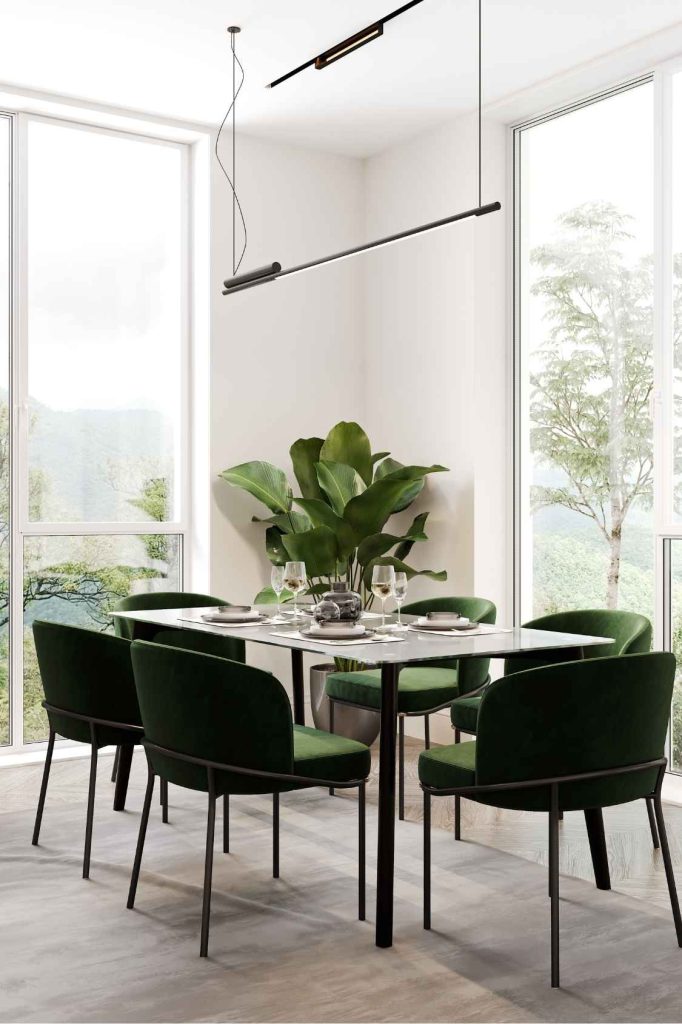
Never underestimate the power of a bit of greenery to breathe life into a space. In Japandi decor, bringing the outdoors in is a must – it reinforces that connection to nature which is at the heart of both Japanese and Scandinavian styles. A houseplant or two in your dining area can do wonders. For example, a potted snake plant or peace lily in the corner introduces fresh green color without demanding much care (both are pretty low-maintenance choices). Even simpler, a vase with a few fresh eucalyptus branches or dried pampas grass on your dining table adds an organic sculptural element and a hint of color. I often snip a sprig of greenery from my garden and plop it in a ceramic jug on the table; it instantly makes the room feel lively and seasonal. Japandi experts often suggest easy-to-care-for plants that complement the space, such as a small bonsai for a Japanese touch or a bamboo plant, and of course using neutral clay or ceramic pots that blend with your palette. If you have the room, a larger plant like a fiddle-leaf fig or monstera can fill an empty corner with lush style (just be sure any plant you choose thrives in your dining room’s light conditions). Arrange these natural accents thoughtfully: a small potted plant on a sideboard or open shelf is perfect for adding warmth without clutter.By incorporating greenery, you’ll notice your dining space feels more balanced and vibrant. It’s that subtle pop of life that reminds everyone that nature is welcome here, completing your serene Japandi dining oasis.
10. Infuse Personal & Cozy Touches

Finally, remember that your dining room should reflect your personality and comfort. Japandi’s minimalist ethos doesn’t mean you can’t have any personal or cozy elements – in fact, the trend encourages a few well-chosen personal touches to avoid a showroom look….The trick is to keep these touches simple and in harmony with the neutral, clean aesthetic. For instance, you might display a single cherished item, like a piece of pottery made by a friend or a vintage bowl passed down in your family. I keep my grandmother’s ceramic serving bowl (in a lovely subdued blue glaze) on my sideboard; its handcrafted charm and sentimental value make the space feel uniquely mine without disrupting the Japandi vibe. Another way to add coziness is through textiles: drape a soft cotton or wool throw over the back of a dining chair or add a couple of cushions upholstered in a neutral linen to your bench seating. In true Scandinavian spirit, a fluffy sheepskin rug or seat cover can add warmth to a wooden chair – I often toss a faux-sheepskin over one chair for a touch of hygge comfort during long dinners. Personal art can also find a place here: a black-and-white photo in a simple oak frame or a small abstract painting you love can be hung on the wall, serving as a subtle focal point that tells a story. The key is moderation: choose a few sentimental or cozy items that add character and warmth while still blending with the overall scheme (think natural colors and materials). By infusing these personal and snug touches, your Japandi dining room won’t just look stylish and serene – it will feel like home, which is the ultimate goal of any decor style. In summary, Japandi-style dining room decor is all about balance: balancing clean lines with cozy textures, neutral tones with natural accents, and minimalist principles with personal warmth. These ten simple tricks – from color palettes and materials to lighting and accessories – offer a roadmap to achieve dining room perfection in a modern Japandi way. The beauty of this style is how livable it is; it creates a space that’s uncluttered yet comfortable, stylish yet unpretentious. Whether you incorporate just a few of these ideas or all ten, your dining room can become more than just a place to eat. It can transform into a calming retreat where every meal is an experience of beauty, comfort, and connection. Enjoy the process of layering your own personality into the Japandi framework, and happy decorating!

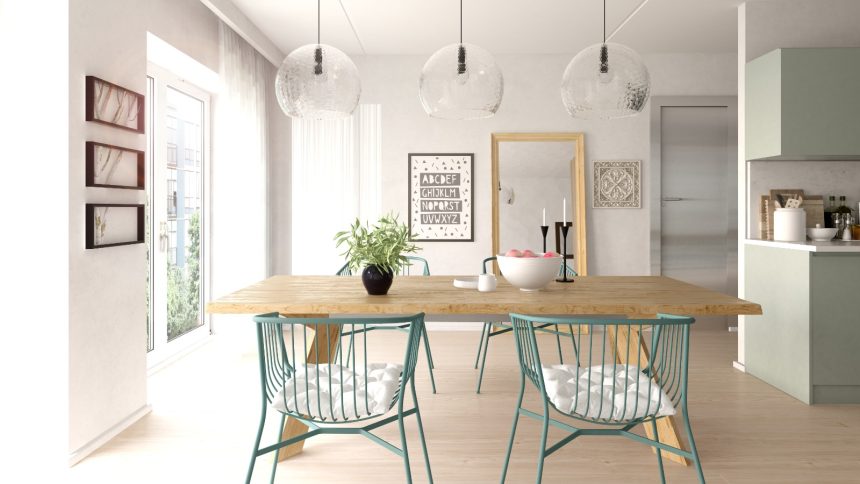
Leave a Reply